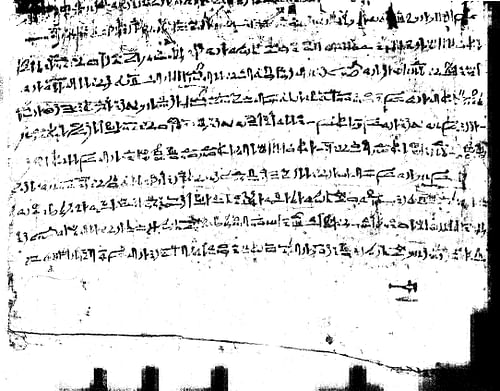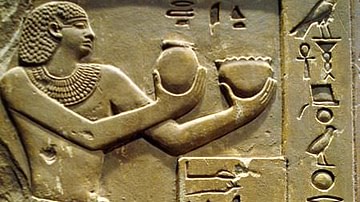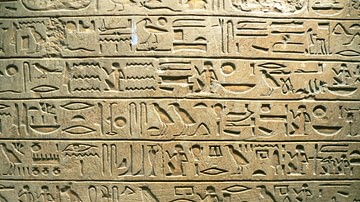The Report of Wenamun (also known as The Tale of Wenamun or The Report of Wenamon) is an Egyptian literary work dated to c. 1090-1075 BCE toward the end of the New Kingdom (c.1570 - c. 1069 BCE). The piece was originally interpreted as an actual official report, but the use of certain stylistic devices (dialogue and symbolism among them) has led scholars to conclude that the work is more along the lines of historical fiction than reportage.
The significance of Wenamun for scholars is the accurate depiction of Egypt's state at the end of the New Kingdom and the beginning of the Third Intermediate Period of Egypt (c. 1069-525 BCE). The New Kingdom was the era of Egypt's empire when conquest, diplomatic negotiations, and trade filled the royal treasury with riches and elevated Egypt's status to one of the greatest nations of the time. The New Kingdom's decline is characterized by a loss of that status, as well as attendant wealth and military strength, until by the reign of Ramesses XI (1107-1077 BCE) the central government was so inconsequential that the country was ruled jointly by Smendes (c. 1077-1051 BCE) the governor of Tanis and the High Priest Herihor (c. 1080-1074 BCE) of Thebes.
The Report of Wenamun is set during this time when Smendes and Herihor commanded a greater respect than the pharaoh and Egypt was no longer regarded by other nations as a country of very great consequence. Wenamun is a government official sent on a mission by Herihor to procure wood from Byblos to refurbish the great Barque of Amun at Thebes, the ceremonial ship used to transport the image of the god at festivals. The story makes clear how, in the past, the wood was regularly provided without a problem but now, with Egypt's status in decline, the foreign prince is less accommodating.
Wenamun as Historical Fiction
Egypt's decline is clearly depicted through the first-person narration of Wenamun as he describes the difficulties he must endure to complete his mission; a mission which was previously accomplished with far greater ease. Egyptologist Miriam Lichtheim comments on the central theme of the story noting how "the empire had been lost and thus so simple an enterprise as the purchase of Lebanese timber could be depicted as a perilous adventure" (224). Wenamun narrates his journey to make a point of how poorly he is treated as a representative of Egypt when once he would have received only the warmest reception.
It is this aspect of the story which continues to attract the attention of scholars, finding details about the state of Egypt at the end of the New Kingdom, but as a work of literature, it is the style and choice of details which make the work so interesting and enjoyable. Lichtheim writes:
What makes the story so remarkable is the skill with which it is told. The Late-Egyptian vernacular is handled with great subtlety. The verbal duels between Wenamun and the prince of Byblos, with their changes of mood and shades of meaning that include irony, represent Egyptian thought and style at their most advanced. What Sinuhe is for the Middle Kingdom, Wenamun is for the New Kingdom: a literary culmination. (224)
The comparison of Wenamun to Sinuhe is apt. The Tale of Sinuhe is a composition from the Middle Kingdom of Egypt, which relates the story of an Egyptian noble driven into exile, his adventures abroad, and return home. Like Wenamun, Sinuhe reflects the time in which it was written. It accurately describes the power and prestige of Egypt at the beginning of the Middle Kingdom with the same power and skill as Wenamun shows in presenting an Egypt in decline.
It is the stylistic devices - tone, mood, characterization – as well as the skillful use of dialogue which has led scholars to conclude the piece is literature. Official reports, throughout Egypt's history, have none of the flair of the manuscript of Wenamun. The piece is regarded as historical fiction because, although the dialogue and even the events might be made up, the story reflects the truth of Egypt and its emissaries at the time it was written. A 'real' Wenamun would have experienced these same kinds of trials and suffered the same sort of frustration.
The text relies on a reader's understanding of how simple the mission to retrieve wood for Amun's ship would have been earlier in the New Kingdom of Egypt when the country was flourishing and neighboring lands could not do enough to court favor with the pharaoh. This juxtaposition of a dreary present with a bright and shining past is an example of the ubi sunt (Latin for "Where have they gone?") motif in literature. Whether the ancient Egyptians invented this type of story (only dubbed ubi sunt by later scholars) is debated, but there is no doubt they perfected it from the Middle Kingdom onwards, and Wenamun is among the best examples of this kind of work.
The Text & Summary
The story is preserved on two papyrus pages of 142 lines known as Papyrus Moscow 120. There are a number of lacunae throughout where the manuscript is damaged, and the end of the story is lost. It is assumed that Wenamun completes his mission and returns to Egypt where he then offers his report.
Written in the form of an official report, Wenamun begins his story with the date and introduces himself and his mission. He journeys from Thebes to Tanis where he is given a ship and supplies by Smendes and sent on his way. He then arrives at Dor, a port town on the coast of Palestine, where he is robbed by one of his own men, who takes the money he brought to pay for the wood. He appeals to the prince of Dor to find his goods but is laughed at for the presumption. The prince tells him that, according to standard practice, if it had been one of the prince's own people who robbed Wenamun, he would replace the loss; but the Egyptian was robbed by one of his own people, and there is nothing to be done but try to find the thief.
Wenamun waits around for nine days but the thief is not found and the money unrestored, so he leaves Dor and solves his problem by robbing a ship belonging to the Tjeker – one of the Sea Peoples – who were related to the people of Dor. He informs the Tjeker on board that he is not actually stealing their money but only holding it until his own is found. He then sails for Byblos where he is poorly received. The prince of Byblos requests that he leave and refuses to grant him an audience for 29 days until one of his court, in a trance, receives a message from the gods that the envoy from Egypt should be seen.
The meeting between Wenamun and the prince of Byblos is among the most skillfully constructed scenes in the story. Wenamun expects an easy transaction in keeping with past traditions but the times have changed – as the prince informs him – and he will no longer give Egypt the wood for free. The prince further explains, bringing out his accounts, that this was never really the case anyway. The great kings of Egypt sent his father and grandfather lavish goods when they needed wood, and so it is wrong of Wenamun to appear at the port empty-handed and expect to be rewarded.
Wenamun argues that he is on a mission from Amun, not any earthly king, and deserves a greater showing of respect. All things belong to Amun, he tells the prince, and so the wood that the prince is claiming as his own is Amun's also. The prince concedes this may be true, but he will still not provide the wood without payment. Wenamun sees there is nothing to be done but bend to the will of the prince. He, therefore, sends a ship to Egypt which returns months later with the goods and treasures, and the prince then has a ship loaded with the wood.
At this point, just when it seems Wenamun can successfully return home, the ships of the Tjeker, which have apparently been searching for him, appear in the harbor and demand his arrest. Wenamun falls to the ground in despair and weeps, and the prince sends a songstress and jugs of wine to him at the shore to console him. The Tjeker are granted an audience with the prince, who tells them that he cannot allow the arrest of an emissary of Amun in his land. He asks them to allow him to send Wenamun on his way and they can catch him somewhere off the coast.
Wenamun sets sail but is blown off his course and loses the Tjeker ships, but when he lands on Alasiya (Cyprus), he is attacked by the people (for reasons unspecified), who try to kill him. He fights his way through the crowd and manages to catch the attention of the princess Hatiba as she is walking from one of her houses to another. He requests sanctuary from her and she grants it, telling him he can spend the night, and at this point, the manuscript breaks off.
Commentary
The author's choice of detail combines to present not only a vivid adventure story and a portrait of a once great nation in decline but also to drive home an existential message about the dangers of clinging to the past. The scene between the prince of Byblos and Wenamun, as noted, is the most dramatic example of this, but Wenamun's reception at Byblos where he is first told to leave and then forced to wait 29 days for an audience is also quite telling. Wenamun's expectation of how he should be treated, based on the traditions of the past, is disappointed. He is living in a new time now with new rules he needs to adjust to.
The use of the Tjeker as adversaries is another fascinating detail in the story touching on a new paradigm. The Tjeker are listed among the tribes who made up the Sea Peoples, one of Egypt's most troublesome enemies from the time of Ramesses II (1279-1213 BCE) through the reign of Ramesses III (1186-1155 BCE). By the time of the late New Kingdom, these people would have been legendary opponents but they are presented sympathetically in the story. The prince of Dor, who is related to the Tjeker, certainly does not go out of his way to help Wenamun when he is robbed but also is behaving according to custom, as he points out, and seems to make some effort to help find the thief. The Tjeker merchants are also presented in a positive light; they have no quarrel with Wenamun until he robs them to make up for his loss.
Traditionally, non-Egyptian characters are not presented sympathetically in Egyptian literature, but in Wenamun, they all are. The prince of Byblos is hardly the villain of the piece and makes clear that Wenamun is operating from a false assumption based on an idealized image of the past. The prince presents a rational argument as to why he will not provide the wood for free. Wenamun relates how the prince explains his case:
He had the daybook [accounts] of his forebears brought and had it read before me. They found entered in his book a thousand deben of silver and all sorts of things. He said to me: "If the ruler of Egypt were the lord of what is mine and I were his servant, he would not have sent silver and gold to say: 'Carry out the business of Amun.' It was not a royal gift that they gave to my father! I too, I am not your servant, nor am I the servant of him who sent you!" (Lichtheim, 226)
Although in the days of Egypt's empire Wenamun would have been treated better, there is nothing especially vindictive or unfair in the way the prince answers his request. He later even gives Wenamun a head start in escaping from the Tjeker, who actually have every right to arrest him.
Through the careful construction of the narrator's character, the author provides an audience with a fully realized individual who is also a type. Wenamun still clings to an image of Egypt as a powerful nation which commands respect and obedience when actually that paradigm no longer applies. Further, as the prince demonstrates, the vision Wenamun clings to of the past is unrealistic. The image of Egypt Wenamun keeps insisting on is now in the past, and this elevates the story from a simple adventure tale of historical interest to true literature.
The tendency to cling to the past and compare it favorably with one's present is a constant of the human condition. People tend to not only remember the 'good old days' but insist that the present should oblige them by conforming to that golden standard. In reality, the 'good old days' are never as perfect as they appear in one's memory and the present is never as terrible as it seems by comparison. Wenamun brings most of his problems on himself and then blames others when they do not respond as he thinks they should. In this, Wenamun is a kind of everyman and the story serves as a warning of the danger of insisting on how life should be instead of accepting life as it is.








